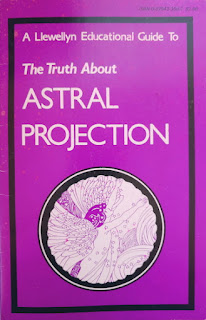The Truth About Astral Projection
by The Llewelyn Editorial Staff
Today I'm reviewing the book A Llewellyn Educational Guide To The Truth About Astral Projection by the Llewellyn Editorial Staff. The copyright is 1983.
For many years, Minnesota-based Llewellyn Publications has published metaphysical books, several of which are about astral projection, including Navigating the Out-of-Body Experience by Graham Nicholls, and The Llewellyn Practical Guide to Astral Projection by Melita Denning and Osborne Phillips (which I haven't reviewed yet, but it's been requested). I tried to get Llewellyn to publish my book Hacking the Out of Body Experience, but they turned me down (their loss: since I self-published the book, they're not dipping into my royalties).
This book is very small. In fact, it's only 32 pages, but the font is tiny, so they cram a lot of information into a small space. Still, it's way too small to go into any depth about anything. And you won't find any astral projection techniques.
I could best sum up this book with three words: "Astral Projection 101." In other words, it's a very basic set of basic information about astral projection and out-of-body experiences. If you're a newbie, coming into the subject for the very first time, this book is a good summary. It talks briefly about some of the experiments that were done with psychics like Ingo Swann and Alex Tanous, and it touches on other pioneers of the subject.
It has a few interesting highlights, one of which is an excerpt from the book Astral Projection by "Yram," (which I've also not reviewed) where the author describes his experience with "astral sex." Since many people ask about astral sex, I'll give Yram's whole quote:
"Her love penetrated into my being under the guise of a general warmth, while a feeling of absolute confidence filled my spirit. On the other hand, my aura penetrated hers and I had the sensation as if melting into her...In no other experience have I had so wide awake a consciousness, no love so powerful, nor a calm and serenity so profound...If you want to be united truly, eternally, with those you love, you must vibrate in harmony with them on all the planes, and in every kind of activity." (pg. 12)
And this matches my (admittedly limited) experience.
This book also talks about how well-known author Jack London became enamored with the out-of-body experience of Ed Morrell, and based his book The Star Rover on it. (Crap, now I've got to buy that too!)
The authors include a 14 point summary of the book themselves on page 29. Here's my summary of their summary:
- Astral projection is safe.
- It is a common human experience.
- It is an extremely pleasant experience.
- It is possible to travel almost anywhere.
- The astral body is a duplicate of the physical body but is composed of a finer "etheric" substance.
- It is connected to the physical body with a "silver cord".
- People frequently project astrally without ever being aware they have done so.
- Other persons, under some circumstances, are able to observe the astral body. Usually, however, it is invisible.
- It is possible to have sex between two astral partners. The experience is blissful beyond description.
- The astral body survives death.
- At death it enters the astral world.
- The astral world is populated by the spirits of the dead and also by its own native inhabitants such as devas and elementals.
- Progress through the astral world is directly related to the progress of one's moral development.
- In the end the soul passes through the astral realm and into the mental realm.
I'm not sure I agree with all of the points above, but in general, most of the book seemed correct to me. The book is just too small to be practical. I'll give it 2 stars out of 5.
Bob Peterson
25 January 2022
----------------------------
If you want me to review
a book about out-of-body experiences or astral projection, send me an
email: bob@robertpeterson.org, but please check the index first to see
if I've already reviewed it. Also, I've got a huge pile of books I'm
planning to review, so don't expect a quick turnaround.
If you like my work, visit my website, robertpeterson.org, where you'll find lots of other free OBE advice and links.

